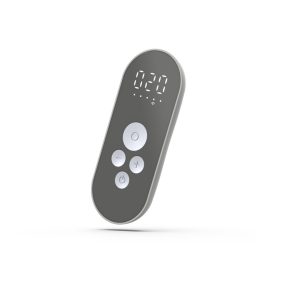Neuromodulation device that stimulates the parasympathetic nervous system function through vagus nerve stimulation (tVNS) and helps restore disrupted balance.
Price includes: Nurosym device, 1x ear electrode, 1x charging cable, 1x carrying bag
What is the vagus nerve?
The vagus nerve, also known as the tenth cranial nerve or the wanderer nerve, is an important part of the peripheral nervous system.
It belongs to the so-called parasympathetic nervous system, which is responsible for regulating rest, relaxation, and regeneration. The vagus nerve is the longest nerve in the body, extending from the brain to the organs in the abdominal cavity.
The primary function of the vagus nerve is to provide a connection between the brain and various organs of the body, including the heart, lungs, gastrointestinal tract, and internal organs. The vagus nerve plays a critical role in regulating heart rate, breathing, digestion, and metabolism.
As part of the parasympathetic nervous system, the vagus nerve acts as a counterpart to the sympathetic nervous system, which is responsible for activating the body and preparing it for physical or emotional stress. The vagus nerve has a calming effect on the body, promoting relaxation, regeneration, and maintaining balance in the autonomic nervous system.
Additionally, the vagus nerve plays an important role in regulating the immune system, inflammatory responses, and mood. Stimulating the vagus nerve can achieve certain therapeutic effects, including reducing inflammation, improving mood, and enhancing overall well-being.
What is vagus nerve stimulation?
Transcutaneous electrical vagus nerve stimulation (abbreviated tVNS) involves stimulating the vagus nerve through the skin.
It is done by transmitting electrical impulses to the tragus, the front part of the outer ear. This stimulation can modulate the function of the vagus nerve and exert various positive effects on the body, such as regulating heart rate, reducing inflammation, and improving overall health.
What is neuromodulation?
Neuromodulation is a technology that directly affects the nerves. It involves altering or modulating neural activity by delivering electrical stimulation or medication directly to the target area.
Neuromodulation devices and treatments can be life-changing. They affect every part of the body and treat almost every disease or symptom, from headaches to tremors, spinal cord injuries, and urinary incontinence. With such a broad therapeutic scope and significant ongoing advancements in biotechnology, it is not surprising that neuromodulation is poised to become one of the most promising methods of the next decade.
Neuromodulation is most commonly associated with chronic pain relief, which is the most frequent indication today.
However, neuromodulation has numerous applications, such as deep brain stimulation (DBS) for treating Parkinson's disease, sacral nerve stimulation for pelvic disorders and incontinence, and spinal cord stimulation for ischemic conditions (angina, peripheral arterial disease).
Additionally, neuromodulation devices can evoke responses that were previously impossible, such as the cochlear implant restoring hearing in deaf patients.
The latest application is vagus stimulation through the tragus (tVNS), which has been shown to be beneficial in conditions such as atrial fibrillation, depression, anxiety, post-COVID-19 syndrome (long COVID), rheumatoid arthritis, and chronic fatigue.
More and more disorders are becoming treatable with neuromodulation.






